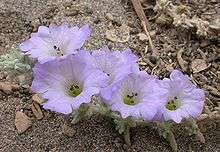Nolana
| Nolana | |
|---|---|
 | |
| Nolana volcanica | |
| Scientific classification | |
| Kingdom: | Plantae |
| (unranked): | Angiosperms |
| (unranked): | Eudicots |
| (unranked): | Asterids |
| Order: | Solanales |
| Family: | Solanaceae |
| Genus: | Nolana L.f. |
| Species | |
|
See text. | |
Nolana (Chilean bell flower) is a genus of hard annual or perennial plants in the nightshade family. The genus is mostly native to Chile and Peru.
Classification
There are a number of synonyms for Nolana: Alibrexia, Aplocarya, Bargemontia, Dolia, Gubleria, Leloutrea, Neudorfia, Osteocarpus, Pachysolen, Periloba, Rayera, Sorema, Teganium, Tula, Velpeaulia, Walberia, and Zwingera.
Nolana is the only genus in the Solanaceae which has a fruit composed of mericarps, although its flower and other vegetative morphology is similar to other plants in this family. It seems to be most closely related to Lycium and Grabowskia.[1]
There are about 85[1] to 89 species.[2]
Selected species
- Nolana acuminata
- Nolana atriplicifolia
- Nolana crassulifolia
- Nolana galapagensis
- Nolana humifusa
- Nolana prostrata
- Nolana rupicola
- Nolana sedifolia
- Nolana tenella
- Nolana paradoxa
References
- 1 2 Dillon, M. O. (2005). The Solanaceae of the Lomas formations of coastal Peru and Chile. Monographs in Systematic Botany 131-56.
- ↑ Dillon, M. O. and J. Wen. Phylogenetic Systematics of Nolana (Solanaceae) and Biogeographic Implications for the Atacama and Peruvian Deserts.
| Wikimedia Commons has media related to Nolana. |
This article is issued from Wikipedia - version of the 3/27/2016. The text is available under the Creative Commons Attribution/Share Alike but additional terms may apply for the media files.